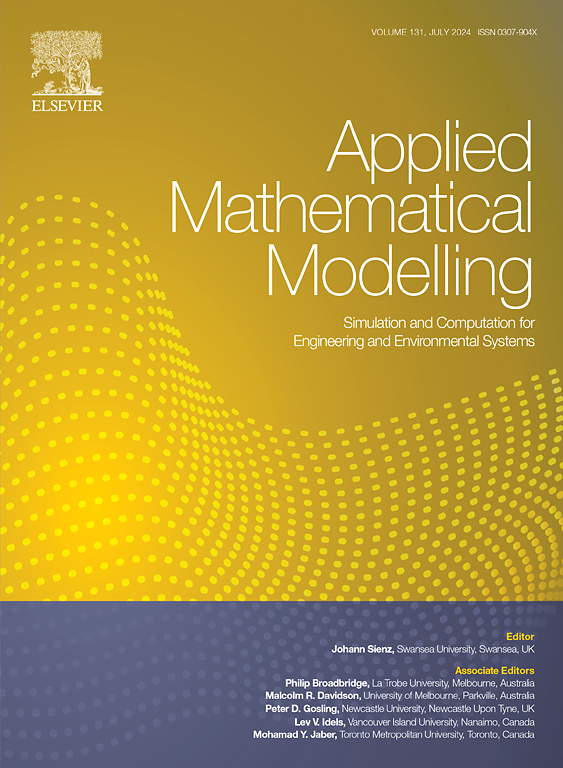考虑设计相关压力载荷的分层拓扑优化
IF 4.4
2区 工程技术
Q1 ENGINEERING, MULTIDISCIPLINARY
引用次数: 0
摘要
流体引起的压力在作用过程中通常会改变大小、方向和施加点,这需要复杂的计算建模。此外,多尺度设计参数具有很强的相互依赖性。本文首次对考虑压力载荷的分层拓扑优化进行了全面的研究。在此框架下,采用经典的固体各向同性材料惩罚方法,结合Heaviside函数、Darcy定律和排水项,实现了固体与空洞之间的平滑过渡。均质化方法在宏观和微观结构优化之间架起了一座桥梁。采用移动渐近线法更新宏观结构设计变量,解决了灵敏度信息非唯一单调性的问题;采用最优准则法更新微观结构设计变量。在不同的压力载荷、尺寸尺度和体积约束下,展示了压力载荷下的分层拓扑优化。计算结果表明,压力载荷对分层结构的拓扑构型和数值结果有显著影响,且压力载荷下的计算时间比固定载荷下的优化时间长10 ~ 20倍。值得注意的是,微观配置在2D和3D实现之间存在很大差异。本文章由计算机程序翻译,如有差异,请以英文原文为准。
Hierarchical topology optimization considering design-dependent pressure loads
Fluid-induced pressures usually alter in magnitude, direction, and application points during the action, which requires sophisticated computational modeling. Furthermore, multiscale design parameters have strong interdependencies. For the first time, this paper presents a comprehensive investigation on the hierarchical topology optimization considering pressure loads. In this framework, a smooth transition between solids and voids is achieved using the classical solid isotropic material penalization method with Heaviside function, Darcy's law and a drainage term are adopted to construct an ideal natural pressure field. The homogenization method builds a bridge between macroscopic and microscopic structural optimization. The macro-structural design variables are updated using the moving asymptotes method, to address the challenge in the case of non-unique monotonicity of the sensitivity information, and the micro-structural design variables are updated by using the optimality criteria method. Hierarchical topology optimization under pressure loads was demonstrated across varying pressure loads, dimensional scales, and volume constraints. The calculation results show that the pressure loads will have significant impacts on the topological configurations and numerical results of the hierarchical structures, and the calculation time under pressure loads is 10 to 20 times longer than the optimization time under fixed loads. Notably, microscopic configurations differ substantially between 2D and 3D implementations.
求助全文
通过发布文献求助,成功后即可免费获取论文全文。
去求助
来源期刊

Applied Mathematical Modelling
数学-工程:综合
CiteScore
9.80
自引率
8.00%
发文量
508
审稿时长
43 days
期刊介绍:
Applied Mathematical Modelling focuses on research related to the mathematical modelling of engineering and environmental processes, manufacturing, and industrial systems. A significant emerging area of research activity involves multiphysics processes, and contributions in this area are particularly encouraged.
This influential publication covers a wide spectrum of subjects including heat transfer, fluid mechanics, CFD, and transport phenomena; solid mechanics and mechanics of metals; electromagnets and MHD; reliability modelling and system optimization; finite volume, finite element, and boundary element procedures; modelling of inventory, industrial, manufacturing and logistics systems for viable decision making; civil engineering systems and structures; mineral and energy resources; relevant software engineering issues associated with CAD and CAE; and materials and metallurgical engineering.
Applied Mathematical Modelling is primarily interested in papers developing increased insights into real-world problems through novel mathematical modelling, novel applications or a combination of these. Papers employing existing numerical techniques must demonstrate sufficient novelty in the solution of practical problems. Papers on fuzzy logic in decision-making or purely financial mathematics are normally not considered. Research on fractional differential equations, bifurcation, and numerical methods needs to include practical examples. Population dynamics must solve realistic scenarios. Papers in the area of logistics and business modelling should demonstrate meaningful managerial insight. Submissions with no real-world application will not be considered.
 求助内容:
求助内容: 应助结果提醒方式:
应助结果提醒方式:


